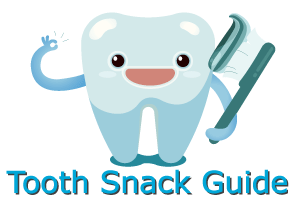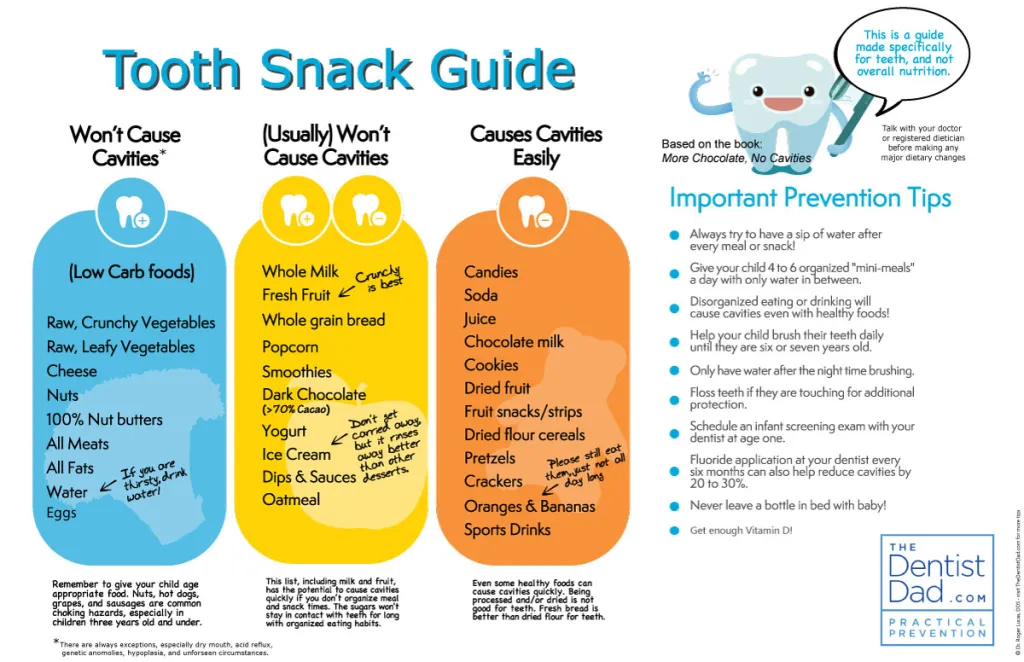Practical Tooth Snack Guide
Get the List of 50 Snack Ideas that aren't Crackers!

by Dr Roger Lucas
This guide for teeth has been printed out over 800,000 times, and is used by hundreds of dentists across the country who want to make preventing cavities practical, and as easy as possible!

(Dentists- if you would prefer a version with your own logo on it, sign up for my email list to get a version you can add your logo to for free, as well as a free training video.)
This guide is a summary of my practical, no-nonsense approach to cavity prevention based on my book, More Chocolate, No Cavities: How Diet Can Keep Your Kid Cavity-Free. When it comes down to it, you can’t out-brush or out-floss a bad tooth diet. However, your teeth behave (slightly) differently than the rest of your body.
Nutrition and preventing cavities are linked… kind of, but not 100%.
It happens to me far too often… I tell a parent their child has eight cavities at age four or five. The parent tells me what nutritious diet they gave their child. They avoided sugar like the plague. But, because they weren’t aware of how foods affect the teeth, their child accidentally has cavities, despite avoiding sugar.
Let’s discuss why nutrition and cavities aren’t 100% linked:
A variety of whole foods is always better for your teeth than processed foods.
.
The most important variables that determine whether a snack food is going to cause cavities or not are:
- Containing carbohydrates
- How long the food stays stuck on the teeth
- How fast the food is usually consumed
Let’s compare fresh fruit to dried fruit.
An apple
- Contains carbohydrates
- Doesn’t stay on the teeth for long because it is crunchy
- Usually is eaten within 5 minutes
So, a fresh apple is on the “good list” for teeth, even though it contains sugar. Just don’t nibble on it 8 times a day, and your teeth will be fine.
A freeze-dried apple
- Contains carbohydrates
- Stays on the teeth for too long
- Can be carried around for 30 minutes

So, dried fruit is worse for your teeth because it is stickier, and more likely to be carried around.
The same is true for bread and crackers. The starch in bread isn’t as sticky as a cracker. Just like fresh fruit is better than dried fruit, fresh bread is better than dried bread (a cracker).

Yes, my list has ice cream on it. Not because you should give it to your kids all of the time, but because I like to give practical advice. Because cavities are based mostly on time, your child’s teeth are actually better off to have ice cream once a day, instead of sticky crackers three times a day, because of the time factor. Bacteria can’t tell whether sugar is from a smoothie or ice cream. As a dad… I know you will give your child sweets occasionally, so might as well do what a dentist dad does.

Dentists… please feel free to hand this snack guide out to patients. It is a great place to start talking teeth, and my diet-based approach has made my practice so much more enjoyable now that I can actually help parents prevent cavities without surprises.
If you prefer another snack guide, the University of Washington’s guide is actually the one that inspired my own. I made changes to my own after my research and “learning from the mistakes” of what many families in my own practice accidentally made. (Hence, why oranges and bananas had to go on the list. I felt bad when a teenager or preschooler accidentally got cavities from not having a variety of fruits.) One way or another, please focus on the foods you give your kids or recommend to your patients (if you are a dentist!)


